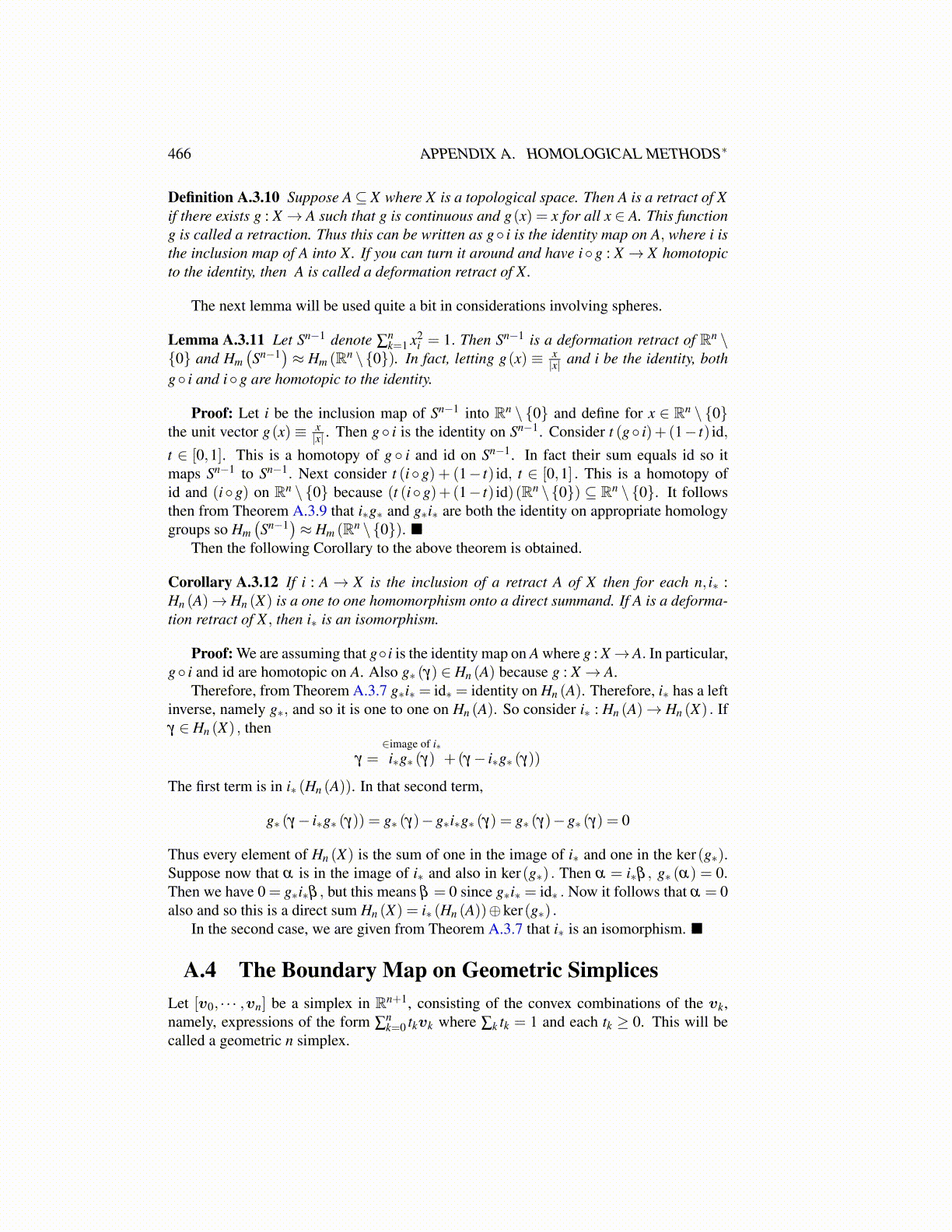
466 APPENDIX A. HOMOLOGICAL METHODS∗
Definition A.3.10 Suppose A⊆ X where X is a topological space. Then A is a retract of Xif there exists g : X → A such that g is continuous and g(x) = x for all x ∈ A. This functiong is called a retraction. Thus this can be written as g◦ i is the identity map on A, where i isthe inclusion map of A into X. If you can turn it around and have i◦g : X → X homotopicto the identity, then A is called a deformation retract of X.
The next lemma will be used quite a bit in considerations involving spheres.
Lemma A.3.11 Let Sn−1 denote ∑nk=1 x2
i = 1. Then Sn−1 is a deformation retract of Rn \{0} and Hm
(Sn−1
)≈ Hm (Rn \{0}). In fact, letting g(x) ≡ x
|x| and i be the identity, bothg◦ i and i◦g are homotopic to the identity.
Proof: Let i be the inclusion map of Sn−1 into Rn \ {0} and define for x ∈ Rn \ {0}the unit vector g(x) ≡ x
|x| . Then g◦ i is the identity on Sn−1. Consider t (g◦ i)+ (1− t) id,t ∈ [0,1]. This is a homotopy of g ◦ i and id on Sn−1. In fact their sum equals id so itmaps Sn−1 to Sn−1. Next consider t (i◦g) + (1− t) id, t ∈ [0,1] . This is a homotopy ofid and (i◦g) on Rn \ {0} because (t (i◦g)+(1− t) id)(Rn \{0}) ⊆ Rn \ {0}. It followsthen from Theorem A.3.9 that i∗g∗ and g∗i∗ are both the identity on appropriate homologygroups so Hm
(Sn−1
)≈ Hm (Rn \{0}). ■
Then the following Corollary to the above theorem is obtained.
Corollary A.3.12 If i : A→ X is the inclusion of a retract A of X then for each n, i∗ :Hn (A)→Hn (X) is a one to one homomorphism onto a direct summand. If A is a deforma-tion retract of X , then i∗ is an isomorphism.
Proof: We are assuming that g◦ i is the identity map on A where g : X→A. In particular,g◦ i and id are homotopic on A. Also g∗ (γ) ∈ Hn (A) because g : X → A.
Therefore, from Theorem A.3.7 g∗i∗ = id∗ = identity on Hn (A). Therefore, i∗ has a leftinverse, namely g∗, and so it is one to one on Hn (A). So consider i∗ : Hn (A)→ Hn (X) . Ifγ ∈ Hn (X) , then
γ =∈image of i∗i∗g∗ (γ) +(γ− i∗g∗ (γ))
The first term is in i∗ (Hn (A)). In that second term,
g∗ (γ− i∗g∗ (γ)) = g∗ (γ)−g∗i∗g∗ (γ) = g∗ (γ)−g∗ (γ) = 0
Thus every element of Hn (X) is the sum of one in the image of i∗ and one in the ker(g∗).Suppose now that α is in the image of i∗ and also in ker(g∗) . Then α = i∗β , g∗ (α) = 0.Then we have 0 = g∗i∗β , but this means β = 0 since g∗i∗ = id∗ . Now it follows that α = 0also and so this is a direct sum Hn (X) = i∗ (Hn (A))⊕ker(g∗) .
In the second case, we are given from Theorem A.3.7 that i∗ is an isomorphism. ■
A.4 The Boundary Map on Geometric SimplicesLet [v0, · · · ,vn] be a simplex in Rn+1, consisting of the convex combinations of the vk,namely, expressions of the form ∑
nk=0 tkvk where ∑k tk = 1 and each tk ≥ 0. This will be
called a geometric n simplex.